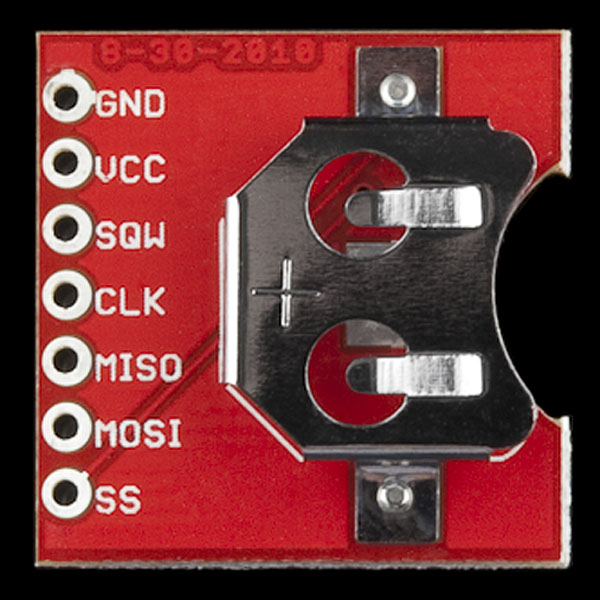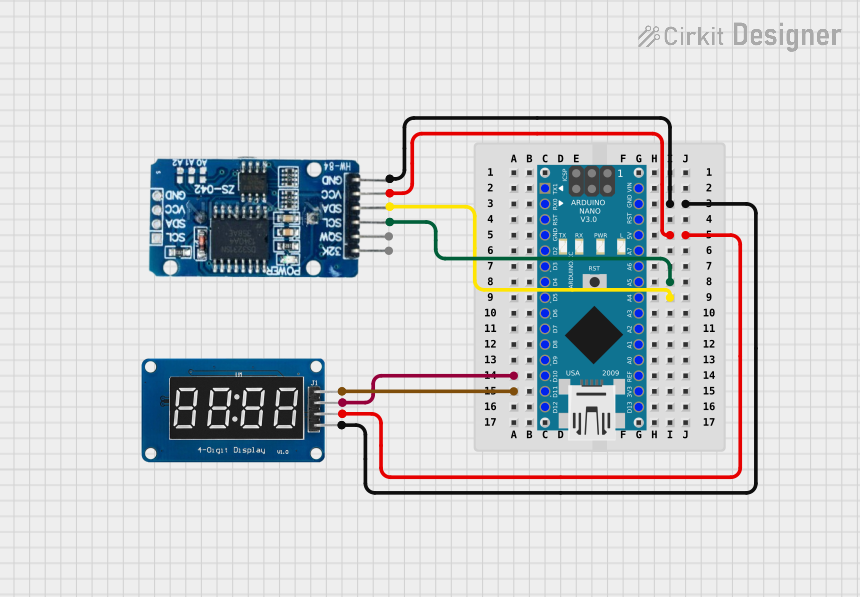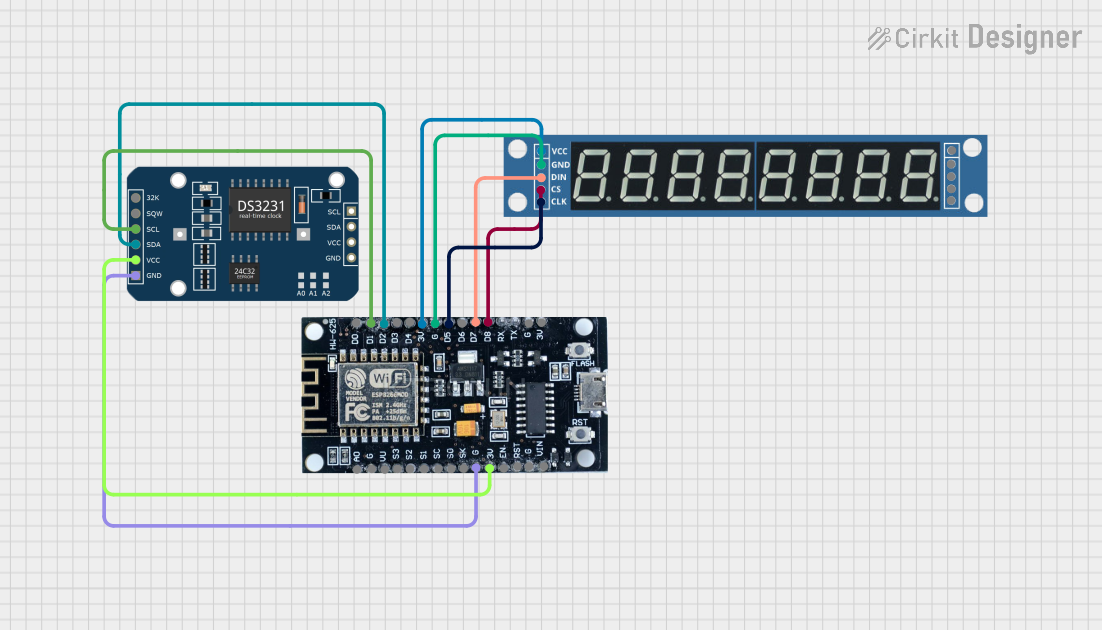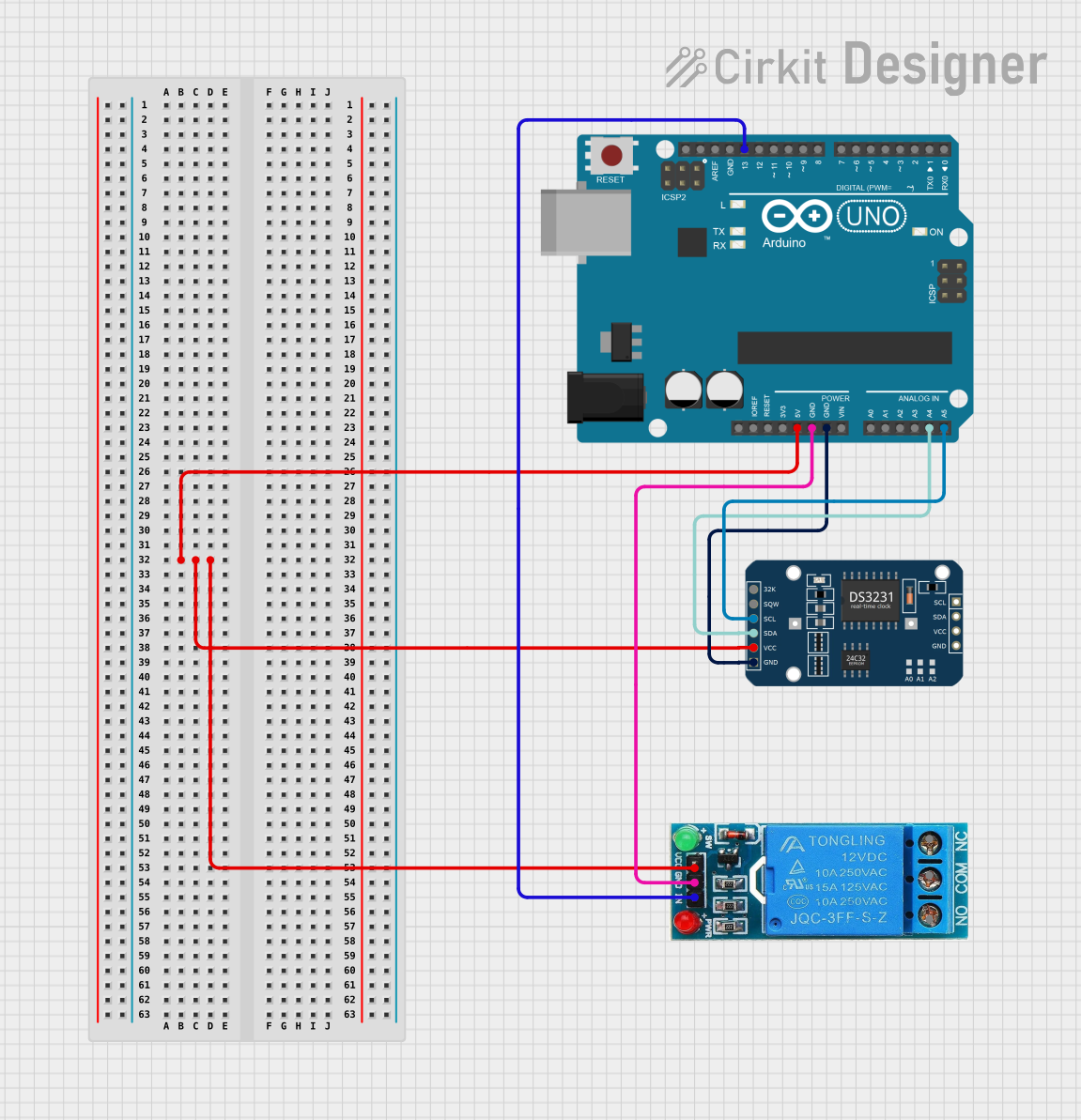
How to Use DS3234: Examples, Pinouts, and Specs

 Design with DS3234 in Cirkit Designer
Design with DS3234 in Cirkit DesignerIntroduction
The DS3234 is a highly accurate real-time clock (RTC) module manufactured by Esparkfun (Part ID: Esparkfun DS3234). It features an integrated temperature sensor, programmable alarms, and SPI communication for fast and reliable data transfer. Designed for low power consumption, the DS3234 is ideal for battery-operated devices and applications requiring precise timekeeping. Additionally, it includes a backup battery feature to maintain timekeeping during power outages.
Explore Projects Built with DS3234

 Open Project in Cirkit Designer
Open Project in Cirkit Designer
 Open Project in Cirkit Designer
Open Project in Cirkit Designer
 Open Project in Cirkit Designer
Open Project in Cirkit Designer
 Open Project in Cirkit Designer
Open Project in Cirkit DesignerExplore Projects Built with DS3234

 Open Project in Cirkit Designer
Open Project in Cirkit Designer
 Open Project in Cirkit Designer
Open Project in Cirkit Designer
 Open Project in Cirkit Designer
Open Project in Cirkit Designer
 Open Project in Cirkit Designer
Open Project in Cirkit DesignerCommon Applications
- Data logging systems
- Battery-powered devices
- Industrial automation
- Time-stamped data collection
- Alarm systems and scheduling applications
Technical Specifications
The DS3234 offers robust features and specifications to meet the needs of various applications. Below are the key technical details:
Key Technical Details
| Parameter | Value |
|---|---|
| Communication Interface | SPI (Serial Peripheral Interface) |
| Operating Voltage | 2.7V to 5.5V |
| Backup Battery Voltage | 2.3V to 3.7V |
| Current Consumption | 1.2 µA (Timekeeping mode with battery) |
| Timekeeping Accuracy | ±2 ppm (0°C to +40°C) |
| Temperature Sensor Range | -40°C to +85°C |
| Alarm Functions | Programmable alarms (daily, hourly, etc.) |
| Package Type | SOIC-20 |
Pin Configuration and Descriptions
The DS3234 has 20 pins, with the most commonly used pins described below:
| Pin Number | Pin Name | Description |
|---|---|---|
| 1 | VCC | Power supply input (2.7V to 5.5V) |
| 2 | GND | Ground |
| 3 | CS | Chip Select (active low) |
| 4 | SCLK | SPI Clock input |
| 5 | MOSI | SPI Master Out Slave In |
| 6 | MISO | SPI Master In Slave Out |
| 7 | INT/SQW | Interrupt or Square Wave Output |
| 8 | VBAT | Backup battery input (2.3V to 3.7V) |
| 9 | RST | Reset input (active low) |
| 10 | 32kHz | 32kHz clock output |
For a complete pinout, refer to the Esparkfun DS3234 datasheet.
Usage Instructions
The DS3234 is straightforward to use in a circuit, especially with microcontrollers like the Arduino UNO. Below are the steps and best practices for integrating the DS3234 into your project.
Connecting the DS3234 to an Arduino UNO
- Power Supply: Connect the VCC pin to the 5V pin on the Arduino and GND to ground.
- SPI Communication:
- Connect the CS pin to Arduino pin 10 (or any other digital pin configured as CS).
- Connect the SCLK pin to Arduino pin 13.
- Connect the MOSI pin to Arduino pin 11.
- Connect the MISO pin to Arduino pin 12.
- Backup Battery: Attach a 3V coin cell battery to the VBAT pin to enable timekeeping during power outages.
- Interrupts (Optional): Use the INT/SQW pin to trigger alarms or generate a square wave signal.
Sample Arduino Code
Below is an example of how to interface the DS3234 with an Arduino UNO to read the current time:
#include <SPI.h>
// Define DS3234 SPI pins
#define CS_PIN 10 // Chip Select pin for DS3234
void setup() {
Serial.begin(9600); // Initialize serial communication
SPI.begin(); // Initialize SPI communication
pinMode(CS_PIN, OUTPUT); // Set CS pin as output
digitalWrite(CS_PIN, HIGH); // Set CS pin high (inactive)
// Initialize DS3234 (e.g., set time, configure alarms, etc.)
initializeRTC();
}
void loop() {
// Read and display the current time
String currentTime = readTime();
Serial.println("Current Time: " + currentTime);
delay(1000); // Wait 1 second before reading again
}
void initializeRTC() {
// Example: Write initialization code for the DS3234
digitalWrite(CS_PIN, LOW); // Select the DS3234
SPI.transfer(0x8E); // Address for control register
SPI.transfer(0x00); // Disable oscillator stop flag
digitalWrite(CS_PIN, HIGH); // Deselect the DS3234
}
String readTime() {
// Example: Read time from the DS3234
digitalWrite(CS_PIN, LOW); // Select the DS3234
SPI.transfer(0x00); // Address for reading seconds
byte seconds = SPI.transfer(0x00); // Read seconds
digitalWrite(CS_PIN, HIGH); // Deselect the DS3234
// Convert seconds to a readable format (for simplicity)
return String(seconds) + " seconds";
}
Best Practices
- Use decoupling capacitors (e.g., 0.1 µF) near the VCC pin to reduce noise.
- Ensure the backup battery is properly connected to maintain timekeeping during power loss.
- Avoid leaving unused pins floating; connect them to GND or VCC as specified in the datasheet.
Troubleshooting and FAQs
Common Issues and Solutions
The DS3234 is not responding to SPI commands.
- Verify the SPI connections (CS, SCLK, MOSI, MISO) and ensure they match the Arduino pin configuration.
- Check that the CS pin is set to LOW before sending SPI commands.
Timekeeping stops when the main power is disconnected.
- Ensure a 3V coin cell battery is connected to the VBAT pin.
- Verify the battery voltage is within the specified range (2.3V to 3.7V).
Incorrect time or date is displayed.
- Confirm that the DS3234 has been initialized with the correct time and date.
- Check for communication errors in the SPI setup.
The INT/SQW pin is not generating interrupts or square waves.
- Verify the configuration of the control register for the desired output.
- Ensure the INT/SQW pin is properly connected to the microcontroller.
FAQs
Q: Can the DS3234 operate without a backup battery?
A: Yes, but it will lose timekeeping functionality during power outages. A backup battery is recommended for uninterrupted operation.
Q: What is the maximum SPI clock speed supported by the DS3234?
A: The DS3234 supports SPI clock speeds up to 4 MHz.
Q: Can I use the DS3234 with a 3.3V microcontroller?
A: Yes, the DS3234 operates within a voltage range of 2.7V to 5.5V, making it compatible with 3.3V systems.
Q: How accurate is the DS3234?
A: The DS3234 has an accuracy of ±2 ppm (parts per million) at 0°C to +40°C, which translates to a deviation of approximately ±1 minute per year.